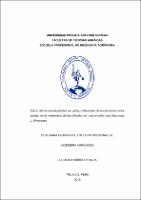Efecto del número de plantas por golpe, a diferentes distanciamientos entre golpes, en el rendimiento de dos híbridos de maíz amarillo duro Zea mays L. (Poaceae)

View/
Download
(application/pdf: 809.3Kb)
(application/pdf: 809.3Kb)
Date
2017Author(s)
Rodriguez Silva, Luciana
Metadata
Show full item recordAbstract
El presente trabajo de investigación se realizó en el Campus II de
la Universidad Privada Antenor Orrego - Trujillo, La Libertad. Tuvo como
objetivo determinar el efecto de dos densidades de siembra (D1: 88867
plantas/ha y D2: 66665 plantas/ha) en el rendimiento de dos híbridos de
maíz amarillo duro (H1: INIA 605 Y H2: DK 7508), a partir de diferentes
distanciamientos entre golpes y número de plantas por golpe: 15 cm (1
planta/golpe), 20 cm (1 planta/golpe), 30 cm (2 plantas/golpe) y 40 cm (2
plantas/golpe) a un distanciamiento entre surcos de 75 cm. El diseño
experimental utilizado fue Parcelas Divididas, con 8 tratamientos y 4
repeticiones. En el estudio se observó que en promedio la densidad de
88867 plantas/ha obtuvo mayor rendimiento que la densidad de 66665
plantas/ha, con una diferencia de 1.16 t/ha. El híbrido que obtuvo mejores
rendimientos fue DK 7508 con un promedio de 13.36 t/ha. El tratamiento
que logró un mayor rendimiento fue la combinación H2G3 (DK 7508 x 30
cm – 2 plantas/golpe, 88867 plantas/ha) con 14.56 t/ha, sin diferencias
estadísticas con los tratamientos del mismo híbrido, pero superiores a las
combinaciones del híbrido INIA 605. En las mediciones de mazorca como:
longitud de mazorca, perímetro de mazorca, ancho de grano, grosor de
grano y longitud de grano no se encontraron diferencias estadísticas, en el
factor densidad, al igual que en floración masculina, floración femenina y
altura de planta. Sin embargo, en diámetro basal de planta se encontraron
efectos altamente significativos, mientras que en altura de mazorca y
diámetro medio de planta hubo diferencias significativas en las densidades
estudiadas. This study was conducted in Campus II, property of the Private
University “Antenor Orrego” (Trujillo, Peru), to determine the effect on grain
yield of two yellow endosperm single hybrids corn (H1: INIA 605 and H2:
DK 7508), at two planting densities (D1: 88867 plant/ha and D2: 66665
plant/ha). Density 1 was achieved by placing hills at 15cm and 30cm, with
1 and 2 plants respectively; whereas for Density 2 hills were at 20cm and
40cm, with 1 and 2 plants each. Rows were at 75 cm apart from each other.
The experimental layout was a factorial in a Split Plot design with four
repetitions, with Hybrids in the main plots and Hills distances in the subplots.
Results indicated that, on average, the highest grain yield was obtained at
Density 1 (88867 plants/ha) with a superiority of 1.16 t/ha over Density 2
(66665 plants/ha). Hybrid DK7508 had the best grain yield with 13.36 t/ha
on average. The treatment combination that reached the highest grain yield
was H2G3 (DK 7508 x 30 cm – 2 plants/hill, 88867 plants/ha) with 14.56
t/ha. With respect to hill distances within the same plant density, there was
no statistical difference in grain yield between 15 cm-hills (1 plant/hill) and
30 cm-hills (2 plants/hill). Same results were obtained between 20 cm-hill (1
plants/hill) and 40 cm-hill (2 plants/hill). This mean that in manual planting
farmers can saved a valuable effort by planting 2 plants per hill, rather than
1 plant per hill, since the latter would mean double the amount of hills. Plant
density did not affected ear length, ear perimeter, grain width, grain thick,
and grain length, the same as with flowering and plant height. On the other
hand, basal and medium stalk diameter and ear height were affected by
different plant densities.
Collections
- Ingeniería Agrónoma [99]

